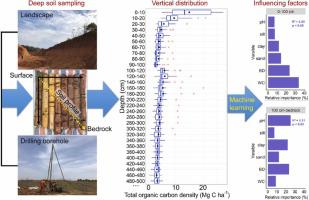Agriculture, Ecosystems & Environment ( IF 6.0 ) Pub Date : 2022-08-22 , DOI: 10.1016/j.agee.2022.108141 Shunhua Yang , Yue Dong , Xiaodong Song , Huayong Wu , Xiaorui Zhao , Jinling Yang , Songchao Chen , Jo Smith , Gan-Lin Zhang

|
Soil organic carbon is one of the most commonly used indicators of soil health, as it plays a vital role in maintaining fertility and combating global warming. Understanding the vertical distribution and controlling factors of organic carbon in the entire regolith, rather than just the routinely defined upper 1 m portion of the soil, is crucial for assessing soil health in a holistic perspective. In this study, 21 boreholes in four different land uses were drilled from the land surface down to the bedrock in a typical subtropical agricultural watershed. The total organic carbon stock in the regolith ranged from 77.8 Mg C ha-1 to 311.8 Mg C ha-1 and the organic carbon content showed a progressive decline from land surface to bedrock. However, on average, only 19.0% of total organic carbon was stored at the depth 0–30 cm and 17.7% between 30 and 100 cm, whereas 63.3% was stored below 100 cm. Total organic carbon stock was significantly higher under paddy fields than under cropland, orchard or woodland in the upper 100 cm (p < 0.05) possibly due to straw incorporation, flooding of the paddy soils and their position on the lower slopes where eroded soil was deposited. However, there was no significant difference in total organic carbon stock below 200 cm (p > 0.05). According to the boosted regression tree analysis, soil texture outperformed the other edaphic factors and was the primary edaphic factor controlling TOC content of the different soils. The results show that there is a large carbon reservoir in the deep regolith. Land use strongly affects the distribution of carbon in the top 100 cm soil layers but has little effect on deep soil organic carbon. Deep TOC were closely linked to soil texture. This study highlights the importance of deep soil organic carbon for soil health and understanding the factors controlling its content for improved estimates of soil carbon storage.
中文翻译:

典型亚热带农业流域深层土壤有机碳垂直分布及影响因素
土壤有机碳是最常用的土壤健康指标之一,因为它在维持肥力和应对全球变暖方面发挥着至关重要的作用。了解整个风化层中有机碳的垂直分布和控制因素,而不仅仅是常规定义的土壤上部 1 m 部分,对于从整体角度评估土壤健康至关重要。在这项研究中,在典型的亚热带农业流域,从地表一直钻到基岩的四种不同土地用途的 21 个钻孔。风化层中的总有机碳储量范围为 77.8 Mg C ha -1至 311.8 Mg C ha -1有机碳含量从地表到基岩呈递减趋势。然而,平均而言,只有 19.0% 的总有机碳储存在 0-30 cm 深度,17.7% 储存在 30-100 cm 之间,而 63.3% 储存在 100 cm 以下。稻田下 100 cm 的总有机碳储量显着高于农田、果园或林地(p < 0.05),这可能是由于稻草的掺入、稻田的洪水及其位于侵蚀土壤沉积的下坡的位置. 然而,200 cm 以下的总有机碳储量没有显着差异(p > 0.05)。根据boosted回归树分析,土壤质地优于其他土壤因子,是控制不同土壤TOC含量的主要土壤因子。结果表明,深部风化层存在较大的碳储层。土地利用对表层 100 cm 土壤层中碳的分布有很大影响,但对深层土壤有机碳影响不大。深层 TOC 与土壤质地密切相关。本研究强调了深层土壤有机碳对土壤健康的重要性,并了解控制其含量的因素以改进对土壤碳储量的估计。











































 京公网安备 11010802027423号
京公网安备 11010802027423号